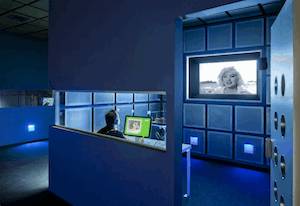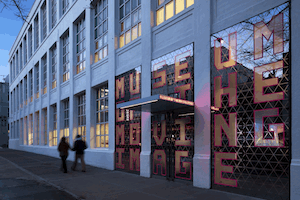Burbank, CA--After a three year, $67 million remodel and expansion, the Museum of the Moving Image in Astoria, New York has reopened with extensive audio-visual upgrades by Electrosonic that offer visitors a renewed focus on the history of moving-image production and the more experimental reaches of film and video art.
- The Museum of the Moving Image in Astoria, New York has reopened with extensive audio-visual upgrades by Electrosonic.
- “The museum is about enabling the public to experience films they haven’t seen in years and learn the history of filmmaking, as well as introducing them to the latest media,” said Electrosonic senior sales consultant Bryan Abelowitz. “We worked with Moving Image throughout the 1990s and did their original ‘Behind the Screen’ core exhibition. Now we’ve come together again for a state-of-the-art, 21st-century upgrade.”
- The new building, designed by architect Thomas Leeser, is located on the site where Paramount’s East Coast production facility, the famed Astoria Studio, stood in the 1920s. Moving Image will now be able to present more screenings and a wider range of programming to the public, and serve twice as many students in its education center. Its popular “Behind the Screen” exhibition also has received a complete technological and artistic overhaul.
- “Moving Image had high expectations from Electrosonic. We worked closely with the client to explore many cost-saving options, while maintaining the architect’s vision and the museum’s goal over a very compressed time schedule,” said Abelowitz.
- Electrosonic’s contributions to the new museum begin in the entrance hallway where the company engineered and installed a 50 by 9-foot projected mural created by five ceiling-mounted Barco edge-blended projectors run from Dataton WATCHOUT. The mural currently features a seven-minute video art piece, “City Glow” (2005) by Chiho Aoshima in collaboration with animator Bruce Ferguson. Two additional wall-mounted 65-inch LCD displays in landscape mode provide scheduling information in the hallway.
- Tucked into the first-floor landing is an informal video screening amphitheater where changing content is displayed via a Barco projector and viewed from bench seating. At opening time, the featured work was a museum commissioned piece by Martha Colburn, “Dolls vs Dictators.”
The amphitheater-style 267-seat main theater is designed to provide unsurpassed visitor experiences with a screen of classic proportions and projection equipment for every format from 16mm to 70mm and HD stereoscopic 3D.
Electrosonic also played a key role in the museum’s theater and screening rooms. The dramatic, amphitheater-style 267-seat main theater is designed to provide unsurpassed visitor experiences with a screen of classic proportions and projection equipment for every format from 16mm to 70mm and HD stereoscopic 3D. The space, according to the museum, was conceived “as a capsule for the imaginary voyage of movie-going” with a wraparound ceiling and walls made of more than a thousand vibrant blue fabric panels that contribute to the sensation of being suspended in space. A stage accommodates live presentations and a mini orchestra pit is used to accompany silent films.
Electrosonic outfitted the theater with a digital cinema server as well as a scaling switcher to permit connection to a variety of sources. A Christie digital cinema projector displays content on a fixed, 34 by 18-foot projection screen. A complete cinema audio system, as well as assisted listening support, is included. A dedicated AMX control system provides on-demand functionality with a docking touch panel onstage, a touch panel in the racks and control buttons at the theater positions.
Digital Media Services provided the “Cinema” equipment for the theater, including the screen, digital cinema projector and Dolby equipment, and undertook the refurbishing and re-installation of the 16/35/70mm film projectors. Electrosonic was responsible for the rack build, AMX control and AV elements.
The 68-seat Celeste and Armand Bartos Screening Room is used for professional motion picture screenings. Electrosonic equipped it with a scaling switcher, two Century JJ 35mm projectors and a Barco RLM-W8 video projector for the fixed 22x9.5-foot projection screen. A high-end audio system includes voice reinforcement as well as assisted listening support. A dedicated AMX control system includes AMX control panels built into the rack, a docking touch panel at the front of the theater and button control panels at the projection positions.

Among the new interactive displays is an Automatic Dialogue Replacement booth, which shows how existing dialog can be replaced. Visitors are invited to “dub” their voices over the lines spoken by Tony Curtis or Marilyn Monroe in “Some like It Hot.”
For the permanent “Behind the Screen” exhibition, which has been dramatically reconceived and upgraded, Electrosonic provided project management, engineering and installation support, and furnished most playback, displays and projection equipment. This core exhibition – a favorite among visitors – seamlessly integrates more than 1,400 artifacts from the museum’s collection of historical materials, nearly four hours of AV materials, and interactive experiences that allow visitors to try their hand at creative processes used in making films and TV programs. Among the new interactive displays is an Automatic Dialogue Replacement booth, which shows how existing dialog can be replaced. For instance, visitors are invited to “dub” their voices over the lines spoken by Tony Curtis or Marilyn Monroe in “Some like It Hot.” At another exhibit, multiple stations allow visitors to create their own stop-motion animations; here, all monitors, cameras, software, and furniture design were upgraded.
Electrosonic also supplied the museum’s Green Room with a wall-mounted 24-inch LCD TV with speakers; it receives the feed from the PTZ camera in the main theater as well as program audio. An intercom to the main projection booth is included.
The museum also houses a 4,000 square foot temporary exhibition space, intended largely for video art installations but built with the flexibility to be used for a wide range of exhibition materials, for which Electrosonic provided infrastructure components.
Electrosonic was faced with a special challenge to provide overall control and connectivity among different areas of the museum that would allow for multifunctional use. Unlike a traditional museum, the Museum of the Moving Image — which takes the whole spectrum of film, television, and digital media as its subject — requires the flexibility of being able to adapt nearly every wall as a potential canvas for digital artwork. The AV design implemented by Electrosonic achieves this by allowing for multiple, cross-functional connections to take place between almost every space in the museum.
The project was designed by Josh Weisberg of Scharff Weisberg, New York. At Electrosonic, Ellen Simich was the project manager, Randy Sherwood project engineer, Chris Cooper site supervisor. Bryan Abelowitz was the sales consultant.










